Xiao Liang
SAIL-Embedding Technical Report: Omni-modal Embedding Foundation Model
Oct 14, 2025Abstract:Multimodal embedding models aim to yield informative unified representations that empower diverse cross-modal tasks. Despite promising developments in the evolution from CLIP-based dual-tower architectures to large vision-language models, prior works still face unavoidable challenges in real-world applications and business scenarios, such as the limited modality support, unstable training mechanisms, and industrial domain gaps. In this work, we introduce SAIL-Embedding, an omni-modal embedding foundation model that addresses these issues through tailored training strategies and architectural design. In the optimization procedure, we propose a multi-stage training scheme to boost the multifaceted effectiveness of representation learning. Specifically, the content-aware progressive training aims to enhance the model's adaptability to diverse downstream tasks and master enriched cross-modal proficiency. The collaboration-aware recommendation enhancement training further adapts multimodal representations for recommendation scenarios by distilling knowledge from sequence-to-item and ID-to-item embeddings while mining user historical interests. Concurrently, we develop the stochastic specialization and dataset-driven pattern matching to strengthen model training flexibility and generalizability. Experimental results show that SAIL-Embedding achieves SOTA performance compared to other methods in different retrieval tasks. In online experiments across various real-world scenarios integrated with our model, we observe a significant increase in Lifetime (LT), which is a crucial indicator for the recommendation experience. For instance, the model delivers the 7-day LT gain of +0.158% and the 14-day LT gain of +0.144% in the Douyin-Selected scenario. For the Douyin feed rank model, the match features produced by SAIL-Embedding yield a +0.08% AUC gain.
Dynamic Generation of Multi-LLM Agents Communication Topologies with Graph Diffusion Models
Oct 09, 2025Abstract:The efficiency of multi-agent systems driven by large language models (LLMs) largely hinges on their communication topology. However, designing an optimal topology is a non-trivial challenge, as it requires balancing competing objectives such as task performance, communication cost, and robustness. Existing frameworks often rely on static or hand-crafted topologies, which inherently fail to adapt to diverse task requirements, leading to either excessive token consumption for simple problems or performance bottlenecks for complex ones. To address this challenge, we introduce a novel generative framework called \textit{Guided Topology Diffusion (GTD)}. Inspired by conditional discrete graph diffusion models, GTD formulates topology synthesis as an iterative construction process. At each step, the generation is steered by a lightweight proxy model that predicts multi-objective rewards (e.g., accuracy, utility, cost), enabling real-time, gradient-free optimization towards task-adaptive topologies. This iterative, guided synthesis process distinguishes GTD from single-step generative frameworks, enabling it to better navigate complex design trade-offs. We validated GTD across multiple benchmarks, and experiments show that this framework can generate highly task-adaptive, sparse, and efficient communication topologies, significantly outperforming existing methods in LLM agent collaboration.
SAIL-VL2 Technical Report
Sep 18, 2025Abstract:We introduce SAIL-VL2, an open-suite vision-language foundation model (LVM) for comprehensive multimodal understanding and reasoning. As the successor to SAIL-VL, SAIL-VL2 achieves state-of-the-art performance at the 2B and 8B parameter scales across diverse image and video benchmarks, demonstrating strong capabilities from fine-grained perception to complex reasoning. Its effectiveness is driven by three core innovations. First, a large-scale data curation pipeline with scoring and filtering strategies enhances both quality and distribution across captioning, OCR, QA, and video data, improving training efficiency. Second, a progressive training framework begins with a powerful pre-trained vision encoder (SAIL-ViT), advances through multimodal pre-training, and culminates in a thinking-fusion SFT-RL hybrid paradigm that systematically strengthens model capabilities. Third, architectural advances extend beyond dense LLMs to efficient sparse Mixture-of-Experts (MoE) designs. With these contributions, SAIL-VL2 demonstrates competitive performance across 106 datasets and achieves state-of-the-art results on challenging reasoning benchmarks such as MMMU and MathVista. Furthermore, on the OpenCompass leaderboard, SAIL-VL2-2B ranks first among officially released open-source models under the 4B parameter scale, while serving as an efficient and extensible foundation for the open-source multimodal community.
UniSearch: Rethinking Search System with a Unified Generative Architecture
Sep 10, 2025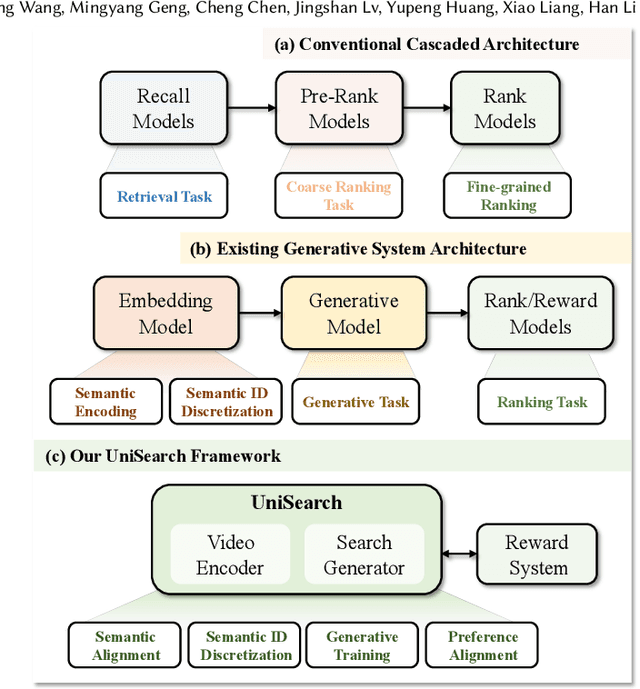
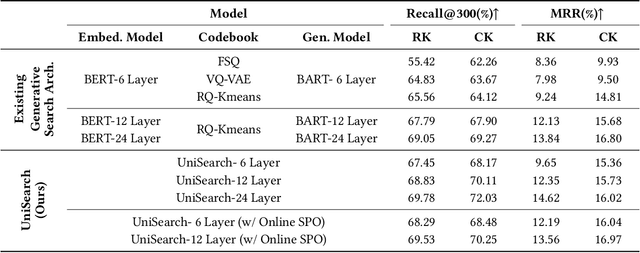
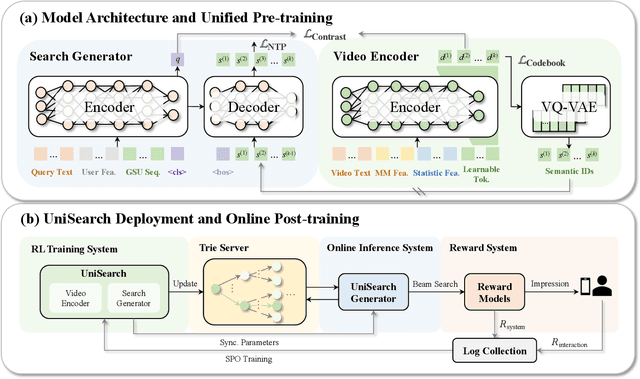
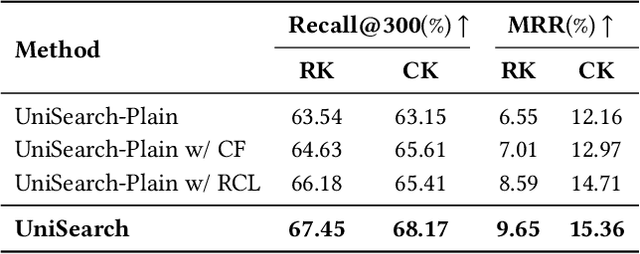
Abstract:Modern search systems play a crucial role in facilitating information acquisition. Traditional search engines typically rely on a cascaded architecture, where results are retrieved through recall, pre-ranking, and ranking stages. The complexity of designing and maintaining multiple modules makes it difficult to achieve holistic performance gains. Recent advances in generative recommendation have motivated the exploration of unified generative search as an alternative. However, existing approaches are not genuinely end-to-end: they typically train an item encoder to tokenize candidates first and then optimize a generator separately, leading to objective inconsistency and limited generalization. To address these limitations, we propose UniSearch, a unified generative search framework for Kuaishou Search. UniSearch replaces the cascaded pipeline with an end-to-end architecture that integrates a Search Generator and a Video Encoder. The Generator produces semantic identifiers of relevant items given a user query, while the Video Encoder learns latent item embeddings and provides their tokenized representations. A unified training framework jointly optimizes both components, enabling mutual enhancement and improving representation quality and generation accuracy. Furthermore, we introduce Search Preference Optimization (SPO), which leverages a reward model and real user feedback to better align generation with user preferences. Extensive experiments on industrial-scale datasets, together with online A/B testing in both short-video and live search scenarios, demonstrate the strong effectiveness and deployment potential of UniSearch. Notably, its deployment in live search yields the largest single-experiment improvement in recent years of our product's history, highlighting its practical value for real-world applications.
OneRec-V2 Technical Report
Aug 28, 2025Abstract:Recent breakthroughs in generative AI have transformed recommender systems through end-to-end generation. OneRec reformulates recommendation as an autoregressive generation task, achieving high Model FLOPs Utilization. While OneRec-V1 has shown significant empirical success in real-world deployment, two critical challenges hinder its scalability and performance: (1) inefficient computational allocation where 97.66% of resources are consumed by sequence encoding rather than generation, and (2) limitations in reinforcement learning relying solely on reward models. To address these challenges, we propose OneRec-V2, featuring: (1) Lazy Decoder-Only Architecture: Eliminates encoder bottlenecks, reducing total computation by 94% and training resources by 90%, enabling successful scaling to 8B parameters. (2) Preference Alignment with Real-World User Interactions: Incorporates Duration-Aware Reward Shaping and Adaptive Ratio Clipping to better align with user preferences using real-world feedback. Extensive A/B tests on Kuaishou demonstrate OneRec-V2's effectiveness, improving App Stay Time by 0.467%/0.741% while balancing multi-objective recommendations. This work advances generative recommendation scalability and alignment with real-world feedback, representing a step forward in the development of end-to-end recommender systems.
CheXPO: Preference Optimization for Chest X-ray VLMs with Counterfactual Rationale
Jul 09, 2025Abstract:Vision-language models (VLMs) are prone to hallucinations that critically compromise reliability in medical applications. While preference optimization can mitigate these hallucinations through clinical feedback, its implementation faces challenges such as clinically irrelevant training samples, imbalanced data distributions, and prohibitive expert annotation costs. To address these challenges, we introduce CheXPO, a Chest X-ray Preference Optimization strategy that combines confidence-similarity joint mining with counterfactual rationale. Our approach begins by synthesizing a unified, fine-grained multi-task chest X-ray visual instruction dataset across different question types for supervised fine-tuning (SFT). We then identify hard examples through token-level confidence analysis of SFT failures and use similarity-based retrieval to expand hard examples for balancing preference sample distributions, while synthetic counterfactual rationales provide fine-grained clinical preferences, eliminating the need for additional expert input. Experiments show that CheXPO achieves 8.93% relative performance gain using only 5% of SFT samples, reaching state-of-the-art performance across diverse clinical tasks and providing a scalable, interpretable solution for real-world radiology applications.
SAILViT: Towards Robust and Generalizable Visual Backbones for MLLMs via Gradual Feature Refinement
Jul 02, 2025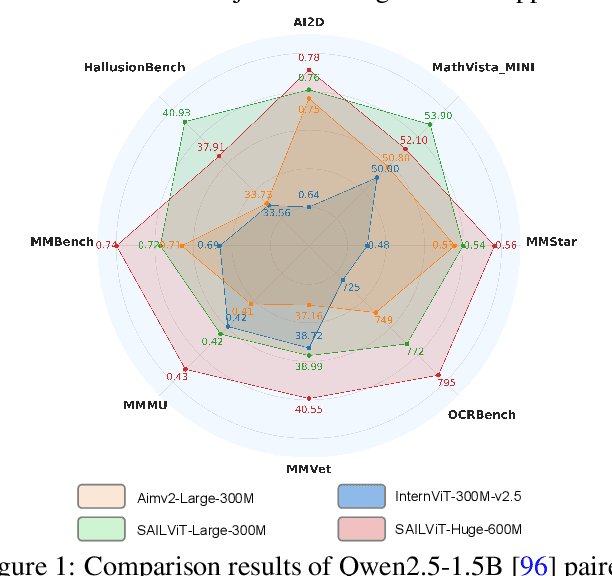


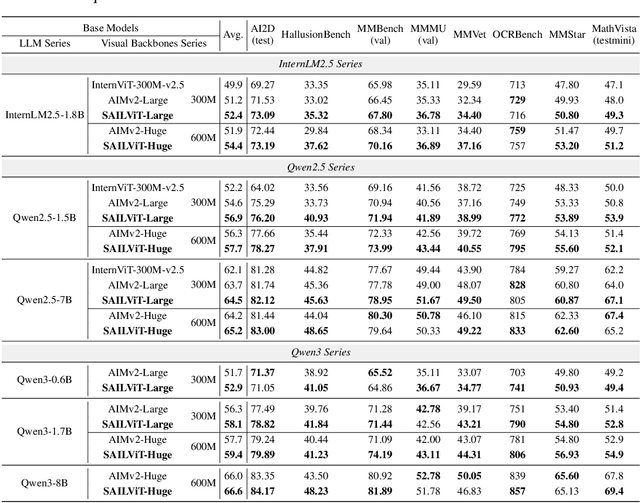
Abstract:Vision Transformers (ViTs) are essential as foundation backbones in establishing the visual comprehension capabilities of Multimodal Large Language Models (MLLMs). Although most ViTs achieve impressive performance through image-text pair-based contrastive learning or self-supervised mechanisms, they struggle to engage in connector-based co-training directly with LLMs due to potential parameter initialization conflicts and modality semantic gaps. To address the above challenges, this paper proposes SAILViT, a gradual feature learning-enhanced ViT for facilitating MLLMs to break through performance bottlenecks in complex multimodal interactions. SAILViT achieves coarse-to-fine-grained feature alignment and world knowledge infusion with gradual feature refinement, which better serves target training demands. We perform thorough empirical analyses to confirm the powerful robustness and generalizability of SAILViT across different dimensions, including parameter sizes, model architectures, training strategies, and data scales. Equipped with SAILViT, existing MLLMs show significant and consistent performance improvements on the OpenCompass benchmark across extensive downstream tasks. SAILViT series models are released at https://huggingface.co/BytedanceDouyinContent.
GuiLoMo: Allocating Expert Number and Rank for LoRA-MoE via Bilevel Optimization with GuidedSelection Vectors
Jun 17, 2025Abstract:Parameter-efficient fine-tuning (PEFT) methods, particularly Low-Rank Adaptation (LoRA), offer an efficient way to adapt large language models with reduced computational costs. However, their performance is limited by the small number of trainable parameters. Recent work combines LoRA with the Mixture-of-Experts (MoE), i.e., LoRA-MoE, to enhance capacity, but two limitations remain in hindering the full exploitation of its potential: 1) the influence of downstream tasks when assigning expert numbers, and 2) the uniform rank assignment across all LoRA experts, which restricts representational diversity. To mitigate these gaps, we propose GuiLoMo, a fine-grained layer-wise expert numbers and ranks allocation strategy with GuidedSelection Vectors (GSVs). GSVs are learned via a prior bilevel optimization process to capture both model- and task-specific needs, and are then used to allocate optimal expert numbers and ranks. Experiments on three backbone models across diverse benchmarks show that GuiLoMo consistently achieves superior or comparable performance to all baselines. Further analysis offers key insights into how expert numbers and ranks vary across layers and tasks, highlighting the benefits of adaptive expert configuration. Our code is available at https://github.com/Liar406/Gui-LoMo.git.
VGR: Visual Grounded Reasoning
Jun 16, 2025Abstract:In the field of multimodal chain-of-thought (CoT) reasoning, existing approaches predominantly rely on reasoning on pure language space, which inherently suffers from language bias and is largely confined to math or science domains. This narrow focus limits their ability to handle complex visual reasoning tasks that demand comprehensive understanding of image details. To address these limitations, this paper introduces VGR, a novel reasoning multimodal large language model (MLLM) with enhanced fine-grained visual perception capabilities. Unlike traditional MLLMs that answer the question or reasoning solely on the language space, our VGR first detects relevant regions that may help to solve problems, and then provides precise answers based on replayed image regions. To achieve this, we conduct a large-scale SFT dataset called VGR -SFT that contains reasoning data with mixed vision grounding and language deduction. The inference pipeline of VGR allows the model to choose bounding boxes for visual reference and a replay stage is introduced to integrates the corresponding regions into the reasoning process, enhancing multimodel comprehension. Experiments on the LLaVA-NeXT-7B baseline show that VGR achieves superior performance on multi-modal benchmarks requiring comprehensive image detail understanding. Compared to the baseline, VGR uses only 30\% of the image token count while delivering scores of +4.1 on MMStar, +7.1 on AI2D, and a +12.9 improvement on ChartQA.
AdaLRS: Loss-Guided Adaptive Learning Rate Search for Efficient Foundation Model Pretraining
Jun 16, 2025Abstract:Learning rate is widely regarded as crucial for effective foundation model pretraining. Recent research explores and demonstrates the transferability of learning rate configurations across varying model and dataset sizes, etc. Nevertheless, these approaches are constrained to specific training scenarios and typically necessitate extensive hyperparameter tuning on proxy models. In this work, we propose \textbf{AdaLRS}, a plug-in-and-play adaptive learning rate search algorithm that conducts online optimal learning rate search via optimizing loss descent velocities. We provide experiment results to show that the optimization of training loss and loss descent velocity in foundation model pretraining are both convex and share the same optimal learning rate. Relying solely on training loss dynamics, AdaLRS involves few extra computations to guide the search process, and its convergence is guaranteed via theoretical analysis. Experiments on both LLM and VLM pretraining show that AdaLRS adjusts suboptimal learning rates to the neighborhood of optimum with marked efficiency and effectiveness, with model performance improved accordingly. We also show the robust generalizability of AdaLRS across varying training scenarios, such as different model sizes, training paradigms, and base learning rate scheduler choices.
 Add to Chrome
Add to Chrome Add to Firefox
Add to Firefox Add to Edge
Add to Edge